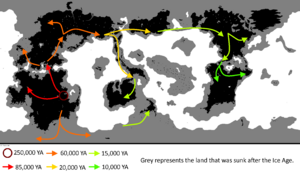Vetuslithic Age: Difference between revisions
Philimania (talk | contribs) mNo edit summary |
Philimania (talk | contribs) |
||
| Line 45: | Line 45: | ||
=== Social organisation === | === Social organisation === | ||
'' | The social organisation of [[Lower Vetuslithic]] societies remains largely unknown to scientists, though [[Lower Vetuslithic]] hominins such as ''Homo rectus'' are likely to have had as slightly more complex social structures than {{wp|chimpanzee}} societies. Later human species such as ''[[Homo aetas]]'' or ''[[Homo nuperni]]'' may have been the first people to invent central campsites or home bases and incorporate them into their foraging and hunting strategies like contemporary {{wp|hunter-gatherers}}, possibly as early as 1.5 million years ago; however, the earliest concrete evidence for the existence of home bases or central campsites (hearths and shelters) among humans only dates back to 700,000 years ago. | ||
Meanwhile, [[Middle Vetuslithic|Middle]], and [[Upper Vetuslithic]] societies were possibly fundamentally {{wp|egalitarian}} and may have rarely or never engaged in organized violence between groups. Some Upper Vetuslithic societies in resource-rich environments (such as [[Hextern]] societies in Eudocia, in what is now X) may have had more complex and hierarchical organization (such as societies with a pronounced hierarchy and a somewhat formal division of labour) and may have engaged in endemic warfare. However, some argue that there was no formal leadership during the Middle and Upper Vetuslithic: like contemporary egalitarian hunter-gatherers such as the X, societies may have made decisions by communal consensus decision making rather than by appointing permanent rulers such as chiefs or monarchs. Several theories to explain the apparent egalitarianism have arisen, most notably the [[Volkist Idea of Primitivity]]. [[Jonathan Turner]] (1976) has hypothesized that egalitarianism may have evolved in Vetuslithic societies because of a need to distribute resources such as food and meat equally to avoid famine and ensure a stable food supply. Even so, other sources claim that most Vetuslithic groups may have been larger, more complex, sedentary, and warlike than most contemporary hunter-gatherer societies, due to occupying more resource-abundant areas than most modern hunter-gatherers who have been pushed into more marginal habitats by agricultural societies. | |||
=== Art === | === Art === | ||
Revision as of 06:39, 11 July 2022
This article is a work in progress. Any information here may not be final as changes are often made to make way for improvements or expansion of lore-wise information about Gentu. Please comment on this article's talk page to share your input, comments and questions. Note: To contribute to this article, contact User:Philimania. |
 Proposed map of the Great Migration, according to artifacts found in certain regions (its accuracy is disputed). | |
| Period | Prehistorical Era |
|---|---|
| Dates | 2.5 mya-10,000 BCE |
| Preceded by | Septun epoch |
| Followed by | Novalithic Age |
| Part of a series on the |
| History of Gentu and Gentish human history (Hodiernus epoch) |
|---|
| ↑ before Homo (Septun epoch) |
|
Prehistorical Era (one-era three-age system) |
|
| Ancient Era |
|
| Antiquity Era |
|
| Middle Era |
|
| Modern Era |
|
| ↓ Future |
The Vetuslithic Age, also known simply as the Vetuslithic, or the Old Stone Age is a period of the Prehistorical Era characterised by the emergence of the earliest stone tools that covers 99% of the period of human technological prehistory. It extends from the earliest known use of stone tools by hominins c. 2.5 million years ago, to the end of the Great Migration c. 10,000 years ago.
The Vetuslithic Age preceded the Novalithic Age. During the Vetuslithic Age, hominins grouped together in small societies such as tribes and subsisted by gathering plants, fishing, and hunting or scavenging wild animals. The Vetuslithic Age is characterized by the use of knapped stone tools, although at the time humans also used wood and bone tools. Other organic commodities were adapted for use as tools, including leather and vegetable fibers; however, due to rapid decomposition, these have not survived to any great degree.
Humankind gradually evolved from early members of the genus Homo, such as Homo rectus, who used simple stone tools, into anatomically modern humans as well as behaviourally modern humans by the Upper Vetuslithic. During the end of the Vetuslithic Age, specifically the Middle or Upper Vetuslithic Age, humans began to produce the earliest works of art and to engage in religious or spiritual behavior such as burial and ritual. Conditions during the Vatuslithic Age went through a set of glacial and interglacial periods in which the climate periodically fluctuated between warm and cool temperatures resulting in the Great Migration. Archaeological and genetic data suggest that the source populations of Vetuslithic humans survived in sparsely-wooded areas and dispersed through areas of high primary productivity while avoiding dense forest-cover. By 60,000 years ago, Humans had migrated to most of Hesterath and the sunken continent of Subarctica, and would have entered Alabon around the same time. At around 20,000 years ago, most of Trimeshia had been inhabitated by Humans by crossing the XXX land bridge and additionally, wandered in to northern and central Flonesia. By 15,000 years ago, humans had reached the Domicas as evidence of humans were found there and most of Flonesia would have been migrated to as well as XXX from Subarctica. At around 10,000 years ago, South Domica would have been inhabitated marking the end of the Vetuslithic and the beginning of the Novalithic
Etymology
The term "Vetuslithic" was coined by archaeologist XXX in 1854. It derives from Alarican: vetus, "old"; and Pylosan: λίθος, lithos, "stone", meaning "old age of the stone" or "Old Stone Age".
Human way of life
Nearly all knowledge of Vetuslithic human culture and way of life comes from archaeology and ethnographic comparisons to modern hunter-gatherer cultures such as the XXX who live similarly to their Vetuslithic Hextern predecessors. The economy of a typical Vetuslithic society was a hunter-gatherer economy. Humans hunted wild animals for meat and gathered food, firewood, and materials for their tools, clothes, or shelters.
Human population density was very low, around only 0.4 inhabitants per square kilometre (1/sq mi). This was most likely due to low body fat, infanticide, women regularly engaging in intense endurance exercise, late weaning of infants, and a nomadic lifestyle. Like contemporary hunter-gatherers, Vetuslithic humans enjoyed an abundance of leisure time unparalleled in both Novalithic farming societies and modern industrial societies. At the end of the Vetuslithic, specifically the Middle or Upper Vetuslithic, humans began to produce works of art such as cave paintings, rock art and jewellery and began to engage in religious behavior such as burials and rituals.
Distribution
TBA
Technology
TBA
Social organisation
The social organisation of Lower Vetuslithic societies remains largely unknown to scientists, though Lower Vetuslithic hominins such as Homo rectus are likely to have had as slightly more complex social structures than chimpanzee societies. Later human species such as Homo aetas or Homo nuperni may have been the first people to invent central campsites or home bases and incorporate them into their foraging and hunting strategies like contemporary hunter-gatherers, possibly as early as 1.5 million years ago; however, the earliest concrete evidence for the existence of home bases or central campsites (hearths and shelters) among humans only dates back to 700,000 years ago.
Meanwhile, Middle, and Upper Vetuslithic societies were possibly fundamentally egalitarian and may have rarely or never engaged in organized violence between groups. Some Upper Vetuslithic societies in resource-rich environments (such as Hextern societies in Eudocia, in what is now X) may have had more complex and hierarchical organization (such as societies with a pronounced hierarchy and a somewhat formal division of labour) and may have engaged in endemic warfare. However, some argue that there was no formal leadership during the Middle and Upper Vetuslithic: like contemporary egalitarian hunter-gatherers such as the X, societies may have made decisions by communal consensus decision making rather than by appointing permanent rulers such as chiefs or monarchs. Several theories to explain the apparent egalitarianism have arisen, most notably the Volkist Idea of Primitivity. Jonathan Turner (1976) has hypothesized that egalitarianism may have evolved in Vetuslithic societies because of a need to distribute resources such as food and meat equally to avoid famine and ensure a stable food supply. Even so, other sources claim that most Vetuslithic groups may have been larger, more complex, sedentary, and warlike than most contemporary hunter-gatherer societies, due to occupying more resource-abundant areas than most modern hunter-gatherers who have been pushed into more marginal habitats by agricultural societies.
Art
TBA
Religion and beliefs
TBA
Diet and nutrition
TBA
See also

